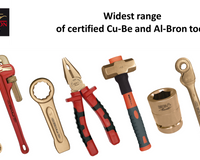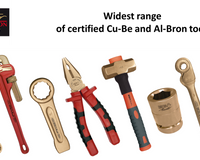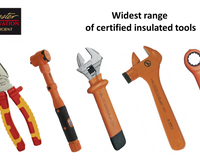What are 1000V insulated tools?
Insulated tools, also referred to as 1000V tools, are tools covered in an insulating material that protects the user from electric hazards.
1000V insulated tools are regulated by the International Standard IEC 60900, which outlines the requirements for insulated and insulating hand tools used for working in live or close to live parts at nominal voltages up to 1000V A.C. and 1500V D.C.
It is important to note that the regulation requires voltage to be turned off before any work is undertaken. The insulated tools are therefore an extra precautionary measure in case there is any “residual voltage” or “returning voltage”.
Are insulated tools always safe to be used in or near live objects?
Insulated tools that meet the IEC 60 900 requirements are safe to be used in or near live objects. However, it is important to remember:
- Tools that present pores, fissures, encrusted elements or if the yellow insulation layer is visible should not be used.
- Insulating carpets and insulated safety shoes are recommended to work under voltage.
- Any contact with water should be avoided while working under voltage.
- Do not ever touch any item that may be under voltage. A voltage tester should always be used to check first.
How can you identify insulated tools?
Even if many insulated tools have a yellow or orange color, it would be a mistake (potentially a fatal mistake) to use the color as the only indication of whether a tool is insulated or not.
Insulated tools are identified through the marking on the insulating material. The sign should include a double triangle followed by a 1000V sign and a reference to the standard.
What tests do insulated tools go through to ensure they are safe?
The IEC 60900 standard requires insulated tools to be tested to up to 10,000V. In addition, tools need to go through 4 additional tests: Adherence test, Impact test, heat resistance propagation test and dielectric penetration test.
- Adherence test: Tests the adherence of the insulating material to the metal elements of the tool
- Impact test: Tests the resilience of the insulating part to external impacts and falls.
- Heat Resistance propagation test: Tests whether the insulating material does not propagate flames.
- Dielectric Penetration Tests: Measures any leakages through the insulated material.
Which are the main criteria you should consider when procuring insulated tools?
The most important factor is compliance against the IEC 60 900 standard. This can only be verified through the symbol (double triangle symbol and immediately adjacent 1000V and the reference to the IEC 60900) placed on the insulating material. Again, the color of the tool or the handle does not necessarily relate to compliance with the standard!
It is also important to ask the manufacturer if the manufacturing date is marked on the tool. This will help the traceability and the planning of future replacements and upgrades.
EGA Master offers a wide range of IEC 60 900 compliant insulated tools. Our tools are already used in the most demanding industrial environments as shown by our references and case studies (see here).
Check our full range of insulated tools here!
Did you find this blog useful? You may also find these other posts interesting:
Non-sparking tools: Learn the basic concepts and be safe!




